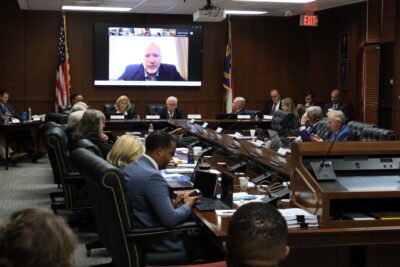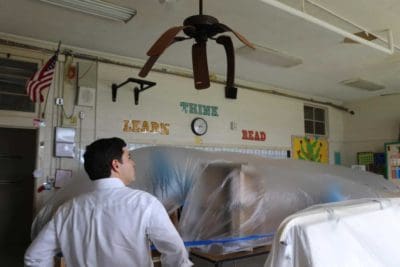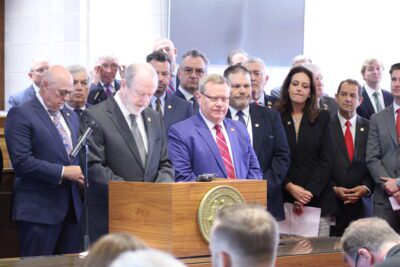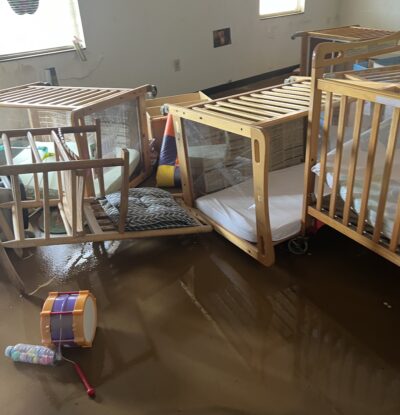
|
|
Democratic Gov. Roy Cooper released his $3.9 billion Helene relief proposal on Wednesday afternoon.
The plan calls for $282 million to go toward education recovery, including $100 million for capital needs for K-12 schools and community colleges, $50 million for public school insurance fund solvency, and $38 million for flexible emergency funding for operations, among other things.
Cooper released his proposal the day before the Republican-led General Assembly is set to reconvene to discuss further Helene aid on Thursday, Oct. 24.
“Helene is the deadliest and most damaging storm ever to hit North Carolina,” Cooper said in a press release. “This storm left a trail of destruction in our beautiful mountains that we will not soon forget, but I know the people of western North Carolina are determined to build back better than ever. These initial funds are a good start, but the staggering amount of damage shows we are very much on the front end of this recovery effort.”
Cooper said on Wednesday that his $3.9 billion proposal is intended to help pay for recovery needs not covered by the federal government or private insurance, but that there will likely be unfunded damages. For context, the state’s saving reserve has approximately $4.47 billion in it, according to the Office of State Budget and Management. Republican leaders have said the state also has about $700 million in a separate disaster relief fund.
On Oct. 10, Cooper signed the state’s initial Helene relief bill into law, which included $273 million dollars of aid to various state agencies along with several voting provisions for voters in counties impacted by Helene.
That first relief bill, which passed the General Assembly unanimously, included $250 million to the state’s Department of Public Safety and Division of Emergency Management, $16 million to the Department of Public Instruction (DPI) to replace lost compensation of school nutrition employees, and school calendar flexibility and compensation for public school districts and employees impacted by Helene closures.
The bill also extended the governor’s state of emergency for Helene until March 1, 2025.
At the time it was passed, state elected officials emphasized it was just the first legislative step to recovery in western North Carolina.
“With all the tragedy we’ve seen in western North Carolina, we’ve also seen an incredible amount of humanity,” said House Speaker Rep. Tim Moore, R-Cleveland. “This is going to be months and months and months. …The folks of western North Carolina need to know they are not going to be forgotten.”
Following Hurricane Florence — the state’s last major hurricane — state lawmakers passed more than half a dozen bills aimed at aiding recovery in central and southeastern North Carolina — allocating a total of $942.4 million in assistance.
However, some state leaders have said the scope of destruction following Helene can more accurately be likened to the damage Hurricane Katrina had on Louisiana in 2005.
“This is unlike anything that we’ve seen in this state,” Republican U.S. Senator Thom Tillis recently told CBS News. “We need increased attention. We need to continue to increase the surge of federal resources.”
Sen. Kevin Corbin, R-Macon, recently told WRAL that lawmakers did not yet know how much total relief funding the state will allocate for Helene, but said “it’ll be in the hundreds of millions, and I think we might even be talking about billions.”
However, Senate Republicans criticized the governor’s request for increased funding for the N.C. Office of Recovery and Residency in a press release on Wednesday, indicating that state Republicans are unlikely to fully implement the governor’s proposed relief items.
On Wednesday, Cooper said that initial damage estimates for Helene are $53 billion, “roughly three times Hurricane Florence estimates in 2018 and the largest in state history.”
The governor’s disaster recovery proposal also includes $650 million for housing assistance and repairs to residential structures, $578 million for various infrastructure repairs, and $422 million to address damage for agricultural enterprises.
You can read his full proposal on the governor’s website.
Education highlights from the governor’s proposal
State Budget Director Kristin Walker presented recommendations for disaster recovery funding with Cooper on Wednesday afternoon.
Here is a look at what Cooper’s proposal includes for education, totaling $282 million:

According to the proposal, more than 1,000 schools are in the western North Carolina counties impacted by Helene, affecting more than 900,000 students.
The estimated damages to state education total $844 million, the proposal says.
Cooper’s proposal calls for $100 million for repairs to K-12 schools and community colleges and $50 million toward public school insurance fund solvency.
Earlier this month, DPI requested $150 million to address building, equipment, and technology loss.
All of DPI’s initial requests — including continued school employee pay and calendar flexibility — were included in the state’s initial relief bill, except for the $150 million for repairs.
“I know the NCGA will appropriate additional funding in terms of building and equipment damage in due time,” state Superintendent Catherine Truitt said in a statement on Oct. 9. “This is a great first step to helping out schools, staff and students recover.”
The N.C. Community College System (NCCCS) has not published a specific funding request, but said during last week’s State Board of Community Colleges meeting that it is asking state lawmakers for student support funds and stabilization dollars due to enrollment loss.
In addition to funds for capital needs, Cooper’s proposal also includes $26 million for “Stay-in-School student assistance” and $2 million for ApprenticeshipNC support.
Finally, the governor’s proposal also addresses early childhood needs.
According to his proposal, 55 child care centers in western North Carolina are damaged and unable to reopen. The proposal calls for $36 million to go toward child care center disaster relief, along with $7 million for child social services support.
Early childhood leaders have asked for funding to go toward capital costs, facility repairs, equipment and materials, and continued teacher pay, EdNC previously reported.
“The child care industry is already fragile and Hurricane Helene has had a devastating impact on many centers,” a Department of Health and Humans Services spokesperson said in an emailed statement to EdNC. “We are currently assessing the needs and will work with the General Assembly on what is needed to recover. Funding for child care is something that has repeatedly been included in the Governor’s budget.”
While the initial state relief bill included funding for DPI, it did not include any funding for community colleges or early childhood.
Cooper said that his $3.9 billion disaster recovery proposal is only a start to the future aid needed to fully recover — from state, federal, and private sources.
“Large scale disasters fueled by climate change in recent years have shown the challenges and enormous costs of recovery as well as the need to ensure structures are hardened are they are rebuilt to withstand future storms,” his press release said. “Successful recoveries require significant early investments to ensure communities have the tools to fully rebuild.”








